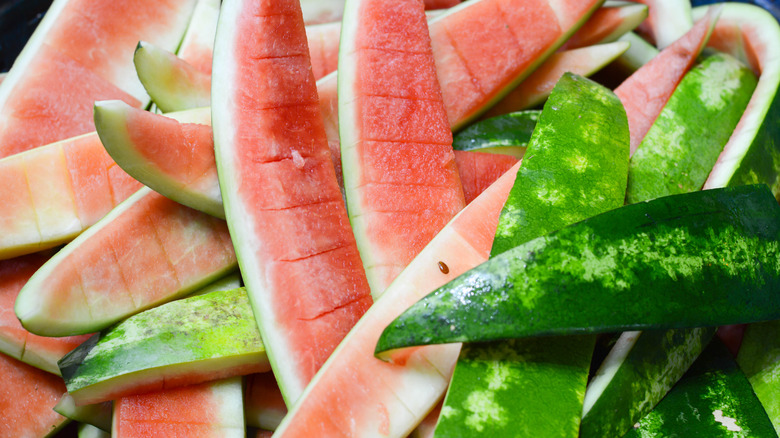What Happens To Your Body When You Eat A Watermelon Rind
Most people who eat watermelon enjoy the sweet pink flesh and throw the rind away. Watermelon rinds are tough and slightly sour, so it isn't surprising that not everyone is a fan of the outer layer of this fruit. There are even some myths out there that suggest the rind is bad for you and shouldn't be eaten under any circumstances. Even though watermelon rinds don't taste quite as good as the flesh of the fruit, you shouldn't be throwing them in the trash can.
Watermelon rinds are a great source of fiber. According to Mind Body Green, the white part of the rind has less sugar and more fiber than the rest of the fruit. "Americans only eat around 10 to 15 grams of fiber per day, much lower than the recommended 25 to 39 grams per day," said Brenna Wallace, M.S., RDN, LDN. "However, adding watermelon rind to your diet can boost your daily fiber intake." Noshing on the watermelon rind can give you a decent dose of fiber without spiking your blood sugar like the flesh of the watermelon can do.
Watermelon rinds have plenty of health benefits
According to Healthline, watermelon rinds offer more than just fiber. They contain an amino acid called citrulline, which has several benefits of its own. Citrulline has been shown to boost your libido and possibly improve athletic performance by delivering more oxygen to the muscles. This amino acid may also reduce blood pressure in people with hypertension. This is because the body converts citrulline into another amino acid called L-arginine and a chemical called nitric oxide (via Mind Body Green). The latter dilates your veins and arteries, which increases blood flow to the heart and muscles.
There are plenty of ways to prepare a watermelon rind to make it more appetizing. Pickling the rind is popular in the Southern United States (via Watermelon.org). You can also juice the rind, which contains a lot of water, or cut it up and stir-fry it like a vegetable. Watermelons rinds are an easy addition to any smoothie and a simple way to add fiber and other nutrients to your morning drink. Whether you cook it, juice it, or eat it plain, save the watermelon rind the next time you cut into this summertime fruit.


